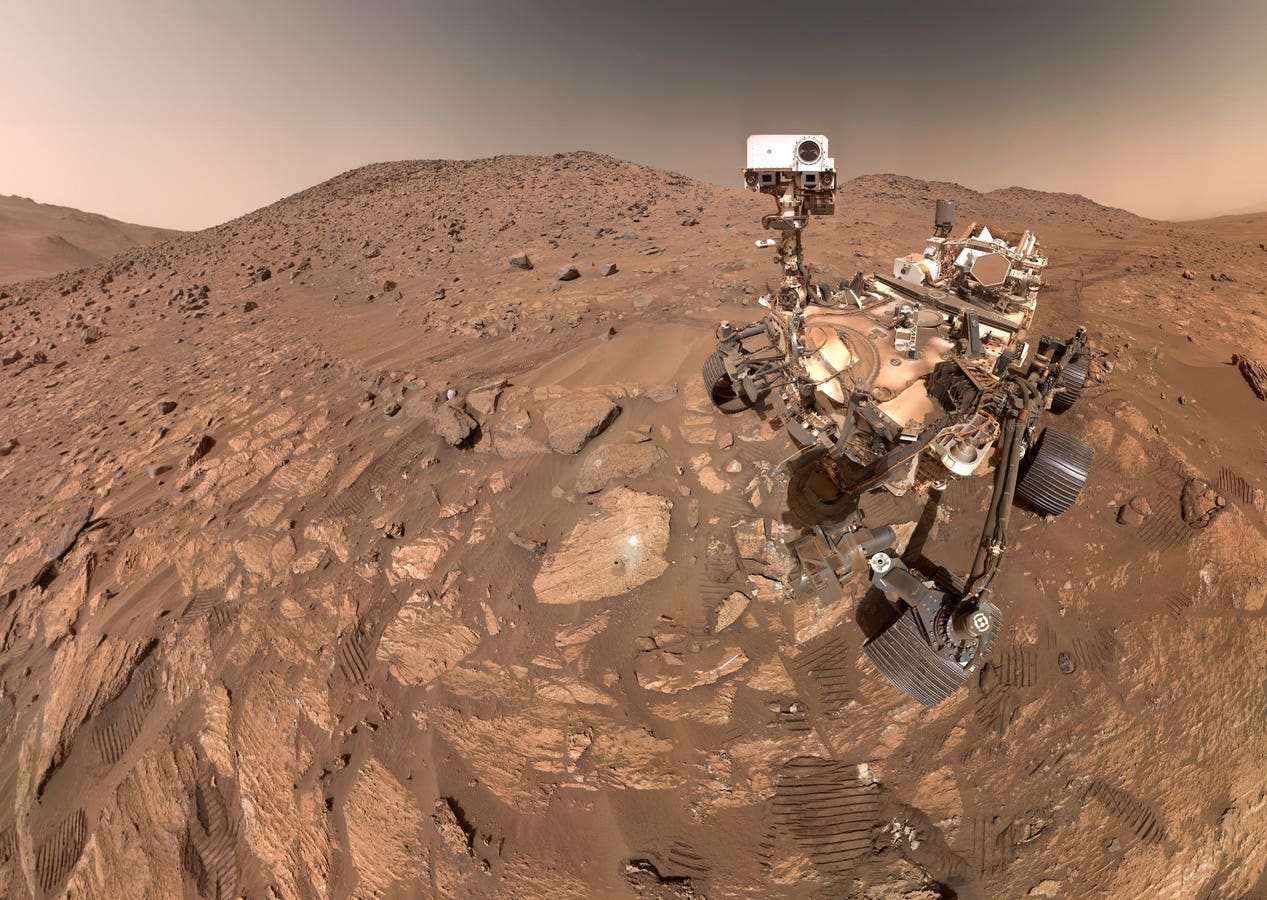NASA’s Perseverance Mars rover took this selfie on July 23, 2024, the 1,218th Martian day, or sol, of the mission. To the left of the rover near the center of the image is the arrowhead-shaped rock nicknamed “Cheyava Falls,” which has features that may bear on the question of whether Mars was home to microscopic life in the distant past.
NASA/JPL-Caltech/MSSS
NASA has announced that a rock sample collected by its Perseverance rover from Jezero Crater last year may contain evidence of ancient microbial life.
The sample, called “Sapphire Canyon,” was extracted from a reddish, arrow-shaped rock named “Cheyava Falls” in the Bright Angel region of Mars in July 2024. It’s one of 27 rock samples collected by Perseverance since it began exploring the Jezero Crater region of Mars — the site of an ancient lake and river delta — in 2021.
“The identification of a potential biosignature on the Red Planet is a groundbreaking discovery, and one that will advance our understanding of Mars,” said Sean Duffy, Secretary of Transportation in the Trump Administration and acting NASA Administrator. He added that it “is the closest we have ever come to discovering life on Mars.”
Life On Mars: ‘Leopard Spots’ Found
According to a paper published by NASA scientists in the journal Nature, distinctive “leopard spots” were detected on the sample, carrying the signature of the minerals vivianite (hydrated iron phosphate) and greigite (iron sulfide). On Earth, Vivianite is found in sediments, peat bogs and around decaying organic matter, while some forms of microbial life can produce greigite.
It’s thought that the spots may be the product of chemical reactions that could have supported microbial life billions of years ago. The spots on the rock could have been left behind by microbial life if it had used the raw ingredients, the organic carbon, sulfur, and phosphorus, in the rock as an energy source, according to NASA. However, both minerals can also be generated without the presence of life.
“The combination of chemical compounds we found in the Bright Angel formation could have been a rich source of energy for microbial metabolisms,” said Joel Hurowitz at Stony Brook University, New York, a Perseverance scientist and lead author of the paper.
NASA’s Perseverance rover discovered leopard spots on a reddish rock nicknamed “Cheyava Falls” in Mars’ Jezero Crater in July 2024. Scientists think the spots may indicate that, billions of years ago, the chemical reactions in this rock could have supported microbial life; other explanations are being considered.
NASA/JPL-Caltech/MSSS
Life On Mars: ‘Potential Biosignature’
For now, the “Sapphire Canyon” sample is being regarded only as a potential biosignature. “Just because we saw all these compelling chemical signatures in the data didn’t mean we had a potential biosignature,” said Hurowitz. “We needed to analyze what that data could mean.” NASA states that it “requires more data or further study before a conclusion can be reached about the absence or presence of life.”
The guarded reaction to the sample comes from the lack of definitive evidence. Perseverance has an onboard laboratory to test samples, but it’s limited in scope. “Astrobiological claims, particularly those related to the potential discovery of past extraterrestrial life, require extraordinary evidence,” said Katie Stack Morgan, Perseverance’s project scientist at NASA’s Jet Propulsion Laboratory in Southern California.
Life On Mars: What Happens Next
NASA confirmed that the data would be made publicly available for further study, but there’s only one way to prove whether the “Sapphire Canyon” sample does contain evidence of life on Mars, and that’s to bring it back to Earth for intensive scientific study.
Perseverance is supposed to be the first in a sequence of missions to bring Martian rock samples home. It’s been dutifully collecting rock samples for years, leaving for eventual return to Earth. “Ultimately, we conclude that analysis of the core sample collected from this unit using high-sensitivity instrumentation on Earth will enable the measurements required to determine the origin of the minerals, organics and textures it contains,” reads the paper.
This illustration shows a concept for a set of future robots working together to ferry back samples from the surface of Mars collected by NASA’s Mars Perseverance rover.
NASA/ESA/JPL-Caltech
Life On Mars: Mars Sample Return Mission
Whether that will ever happen remains to be seen. NASA and the European Space Agency’s Mars sample-return mission would round up the samples — possibly using Perseverance or possibly using drones like the Ingenuity helicopter — and deposit them in a Mars Ascent Vehicle, which would launch a capsule back to Earth. That won’t happen until the late-2030s at the earliest — though the mission appears to have entirely stalled in recent years, with NASA appealing in April 2024 to private industry to help it trim the expected $11 billion price tag.
With the Trump Administration planning to cut NASA’s budget by as much as 24% this year, confirmation of life on Mars looks set to remain tantalizingly out of reach.
Wishing you clear skies and wide eyes.









